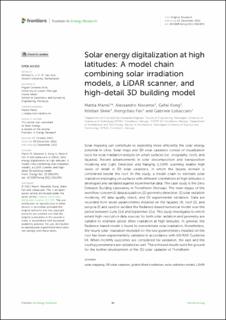| dc.contributor.author | Manni, Mattia | |
| dc.contributor.author | Nocente, Alessandro | |
| dc.contributor.author | Kong, Gefei | |
| dc.contributor.author | Skeie, Kristian Stenerud | |
| dc.contributor.author | Fan, Hongchao | |
| dc.contributor.author | Lobaccaro, Gabriele | |
| dc.date.accessioned | 2023-01-23T08:51:22Z | |
| dc.date.available | 2023-01-23T08:51:22Z | |
| dc.date.created | 2023-01-10T10:11:50Z | |
| dc.date.issued | 2022 | |
| dc.identifier.citation | Frontiers in Energy Research. 2022, 10 . | en_US |
| dc.identifier.issn | 2296-598X | |
| dc.identifier.uri | https://hdl.handle.net/11250/3045147 | |
| dc.description.abstract | Solar mapping can contribute to exploiting more efficiently the solar energy potential in cities. Solar maps and 3D solar cadasters consist of visualization tools for solar irradiation analysis on urban surfaces (i.e., orography, roofs, and façades). Recent advancements in solar decomposition and transposition modeling and Light Detection and Ranging (LiDAR) scanning enable high levels of detail in 3D solar cadasters, in which the façade domain is considered beside the roof. In this study, a model chain to estimate solar irradiation impinging on surfaces with different orientations at high latitudes is developed and validated against experimental data. The case study is the Zero Emission Building Laboratory in Trondheim (Norway). The main stages of the workflow concern (1) data acquisition, (2) geometry detection, (3) solar radiation modeling, (4) data quality check, and (5) experimental validation. Data are recorded from seven pyranometers installed on the façades (4), roof (2), and pergola (1) and used to validate the Radiance-based numerical model over the period between June 21st and September 21st. This study investigates to which extent high-resolution data sources for both solar radiation and geometry are suitable to estimate global tilted irradiation at high latitudes. In general, the Radiance-based model is found to overestimate solar irradiation. Nonetheless, the hourly solar irradiation modeled for the two pyranometers installed on the roof has been experimentally validated in accordance with ASHRAE Guideline 14. When monthly outcomes are considered for validation, the east and the south pyranometers are validated as well. The achieved results build the ground for the further development of the 3D solar cadaster of Trondheim. | en_US |
| dc.language.iso | eng | en_US |
| dc.rights | CC BY 4.0 | * |
| dc.rights.uri | http://creativecommons.org/licenses/by/4.0/ | * |
| dc.title | Solar energy digitalization at high latitudes: A model chain combining solar irradiation models, a LiDAR scanner, and high-detail 3D building model | en_US |
| dc.type | Peer reviewed | en_US |
| dc.type | Journal article | en_US |
| dc.description.version | publishedVersion | en_US |
| dc.rights.holder | © 2022 The authors | en_US |
| dc.source.pagenumber | 17 | en_US |
| dc.source.volume | 10 | en_US |
| dc.source.journal | Frontiers in Energy Research | en_US |
| dc.identifier.doi | 10.3389/fenrg.2022.1082092 | |
| dc.identifier.cristin | 2103786 | |
| dc.relation.project | Norges forskningsråd: 324243 | en_US |
| cristin.ispublished | true | |
| cristin.fulltext | original | |
| cristin.qualitycode | 1 | |

